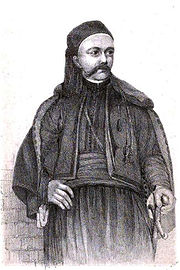
John Shae Perring
Encyclopedia

Kingdom of Great Britain
The former Kingdom of Great Britain, sometimes described as the 'United Kingdom of Great Britain', That the Two Kingdoms of Scotland and England, shall upon the 1st May next ensuing the date hereof, and forever after, be United into One Kingdom by the Name of GREAT BRITAIN. was a sovereign...
engineer
Engineer
An engineer is a professional practitioner of engineering, concerned with applying scientific knowledge, mathematics and ingenuity to develop solutions for technical problems. Engineers design materials, structures, machines and systems while considering the limitations imposed by practicality,...
, anthropologist and Egyptologist, most notable for his work excavating and documenting Egyptian pyramid
Pyramid
A pyramid is a structure whose outer surfaces are triangular and converge at a single point. The base of a pyramid can be trilateral, quadrilateral, or any polygon shape, meaning that a pyramid has at least three triangular surfaces...
s. In the field of Egyptology
Egyptology
Egyptology is the study of ancient Egyptian history, language, literature, religion, and art from the 5th millennium BC until the end of its native religious practices in the AD 4th century. A practitioner of the discipline is an “Egyptologist”...
his work is fairly obscure and his anthropological work is even more obscure.
In 1837 Perring and British archaeologist Richard William Howard Vyse
Richard William Howard Vyse
Major-General Sir Richard William Howard Vyse, KCMG was a British soldier, anthropologist and Egyptologist. He was also Member of Parliament for Beverley and Honiton .-Family life:...
began excavating at Giza - they were later joined by Giovanni Battista Caviglia. They used gunpowder to force their way into several monuments and then to reach hidden chambers within them, such as the burial chamber of the pyramid of Menkaure, documenting them as they went. When Caviglia left the team to work independently, Perring became Vyse's assistant and when Vyse himself left for England in 1837 Perring continued the excavation with Vyse's financial support.
As part of his work Perring created several maps, plans and cross-sections of the pyramids at Abu Roasch, Gizeh, Abusir, Saqqara
Saqqara
Saqqara is a vast, ancient burial ground in Egypt, serving as the necropolis for the Ancient Egyptian capital, Memphis. Saqqara features numerous pyramids, including the world famous Step pyramid of Djoser, sometimes referred to as the Step Tomb due to its rectangular base, as well as a number of...
and Dahshur
Dahshur
Dahshur , is a royal necropolis located in the desert on the west bank of the Nile approximately 40 kilometres south of Cairo...
. He was the first to explore the interior of the Pyramid of Userkaf
Pyramid of Userkaf
The Pyramid complex of Userkaf is located in the pyramid field at Saqqara. Constructed in dressed stone, with a core of rubble, the pyramid now resembles a conical hill just to the north of the Step Pyramid of Djoser Netjerikhet.-References:...
at Saqqara
Saqqara
Saqqara is a vast, ancient burial ground in Egypt, serving as the necropolis for the Ancient Egyptian capital, Memphis. Saqqara features numerous pyramids, including the world famous Step pyramid of Djoser, sometimes referred to as the Step Tomb due to its rectangular base, as well as a number of...
in 1839, through a robber's tunnel first discovered by Orazio Marucchi
Orazio Marucchi
Orazio Marucchi was an Italian archaeologist and author of the Manual of Christian Archaeology. He served as Professor of Christian Archaeology at the University of Rome and director of the Christian and Egyptian museums at the Vatican Museums. He was also a member of the Pontifical Commission of...
in 1831. Perring thought the pyramid belonged to Djedkare. The pyramid was first correctly identified by Egyptologist Cecil Firth
Cecil Mallaby Firth
Cecil Mallaby Firth was a British Egyptologist.Firth worked in Nubia of 1907 to 1911, then it started to explore the complex of Djoser's Step Pyramid in Saqqara where, in 1924, he discovered the serdab of the Pharaoh, which is now in the Cairo Museum.Firth then worked in collaboration with James E...
in 1928 (though Firth died in 1931 and excavations there only recommenced in 1948, under Jean-Philippe Lauer
Jean-Philippe Lauer
Jean-Philippe Lauer , was a French architect and Egyptologist.He was born in Paris, France and originally studied architecture, but in 1926 he went to Egypt. Here he met and married Marguerite Jouguet....
). Perring added some graffiti inside the Red Pyramid
Red Pyramid
The Red Pyramid, also called the North Pyramid, is the largest of the three major pyramids located at the Dahshur necropolis. Named for the rusty reddish hue of its stones, it is also the third largest Egyptian pyramid, after those of Khufu and Khafra at Giza. At the time of its completion, it was...
at Dahshur
Dahshur
Dahshur , is a royal necropolis located in the desert on the west bank of the Nile approximately 40 kilometres south of Cairo...
, which can still be viewed today.
Perring's work resulted in his three-volume "The Pyramids of Gizeh", published in 1839 to 1842. Vyse also published Perring's sketches in the third volume of his own three-part work "Appendix to Operations carried on at the Pyramids of Gizeh in 1837".

